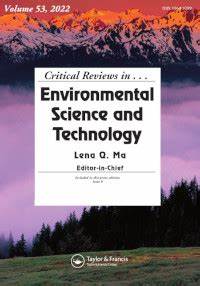水环境中被忽视的非氧化性抗菌剂(NOAMs)风险
IF 13.2
1区 环境科学与生态学
Q1 ENVIRONMENTAL SCIENCES
Critical Reviews in Environmental Science and Technology
Pub Date : 2025-10-06
DOI:10.1080/10643389.2025.2563346
引用次数: 0
摘要
非氧化抗菌剂(NOAMs)提供持久的微生物控制,而不会与其他成分发生反应或导致设备腐蚀,但其环境和健康风险往往被忽视。常见的NOAMs包括季铵盐化合物(QACs)、醛类、异噻唑啉酮类、唑类和双胍类。它们广泛用于家庭、医疗保健、工业、水处理和农业,通过废水、医院/工业来源和城市/农业径流进入环境。医院/工业废水和反渗透(RO)浓缩液中NOAM浓度可达mg/L。全球地表水、沉积物和污水污泥中均检测到NOAMs,中位浓度分别为0.01-0.1 μg/L、3.2-12 μg/kg和5-7562 μg/kg。与NOAMs相关的风险包括抗生素耐药性增加、对水生生物的生态毒性以及潜在的健康危害。暴露于亚抑制浓度的QACs、西甲酰胺或氯己定可使对其他NOAMs和抗生素的耐药性提高1.3至100倍以上。与个人护理产品(PPCPs)和消毒副产物(DBPs)相比,NOAMs对发光细菌、藻类、水蚤和鱼类表现出相当或更高的生态毒性。像QACs、异噻唑啉酮和多菌灵这样的NOAMs可以通过多种接触途径引起皮肤过敏、肝脏炎症、纤维化或神经元损伤。大多数NOAMs需要数周或更长时间才能完全生物降解。NOAMs和PPCPs表现出相似的生物降解性,两者的可生物降解性都不如DBPs。臭氧与QACs、多菌灵和氯甲基异噻唑啉酮(CMIT)的反应速率低于10 M−1s−1。羟基自由基与NOAMs反应迅速(>109 M−1s−1),而硫酸盐自由基与NOAMs的反应尚不清楚。未来的研究需要扩大环境监测、多终点毒性评估、高NOAM压力下的耐药机制和先进的处置策略。本文章由计算机程序翻译,如有差异,请以英文原文为准。
Overlooked risks of non-oxidizing antimicrobials (NOAMs) in water environments
Non-oxidizing antimicrobials (NOAMs) provide long-lasting microbial control without reacting with other components or causing equipment corrosion, yet their environmental and health risks are often overlooked. Common NOAMs include quaternary ammonium compounds (QACs), aldehydes, isothiazolinones, azoles, and biguanides. They are widely used in households, healthcare, industry, water treatment, and agriculture, entering the environment through wastewater, hospital/industrial sources, and urban/agricultural runoff. NOAM concentrations can reach mg/L in hospital/industrial wastewater and reverse osmosis (RO) concentrate. NOAMs have been detected globally in surface waters, sediments, and sewage sludge, with median concentrations of 0.01–0.1 μg/L, 3.2–12 μg/kg, and 5–7562 μg/kg, respectively. Risks associated with NOAMs include increased antibiotic resistance, ecotoxicity to aquatic organisms, and potential health hazards. Exposure to sub-inhibitory concentrations of QACs, cetrimide, or chlorhexidine can enhance resistance to other NOAMs and antibiotics by 1.3 to over 100 times. NOAMs exhibit comparable or higher ecotoxicity to luminescent bacteria, algae, daphnids, and fish compared to personal care products (PPCPs) and disinfection by-products (DBPs). NOAMs like QACs, isothiazolinones, and carbendazim can cause skin allergies, liver inflammation, fibrosis, or neuronal damage via multiple exposure routes. Most NOAMs require several weeks or more for complete biodegradation. NOAMs and PPCPs show similar biodegradability, both being less biodegradable than DBPs. Ozone reacts with QACs, carbendazim, and chloromethylisothiazolinone (CMIT) at rates below 10 M−1s−1. Hydroxyl radicals react rapidly with NOAMs (>109 M−1s−1), while sulfate radical reactions with NOAMs are poorly understood. Future research requires expanded environmental monitoring, multi-endpoint toxicity assessments, resistance mechanisms under high NOAM pressure, and advanced disposal strategies.
求助全文
通过发布文献求助,成功后即可免费获取论文全文。
去求助
来源期刊
CiteScore
27.30
自引率
1.60%
发文量
64
审稿时长
2 months
期刊介绍:
Two of the most pressing global challenges of our era involve understanding and addressing the multitude of environmental problems we face. In order to tackle them effectively, it is essential to devise logical strategies and methods for their control. Critical Reviews in Environmental Science and Technology serves as a valuable international platform for the comprehensive assessment of current knowledge across a wide range of environmental science topics.
Environmental science is a field that encompasses the intricate and fluid interactions between various scientific disciplines. These include earth and agricultural sciences, chemistry, biology, medicine, and engineering. Furthermore, new disciplines such as environmental toxicology and risk assessment have emerged in response to the increasing complexity of environmental challenges.
The purpose of Critical Reviews in Environmental Science and Technology is to provide a space for critical analysis and evaluation of existing knowledge in environmental science. By doing so, it encourages the advancement of our understanding and the development of effective solutions. This journal plays a crucial role in fostering international cooperation and collaboration in addressing the pressing environmental issues of our time.

 求助内容:
求助内容: 应助结果提醒方式:
应助结果提醒方式:


